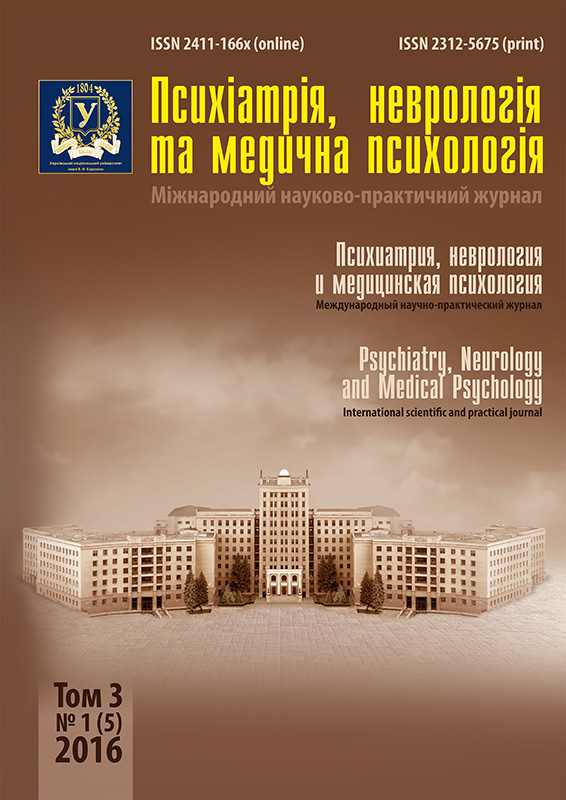Фітнес-аддикція у жінок: концептуалізація феномену та обґрунтування психодіагностичного інструменту
Анотація
В роботі проаналізовано феномен фітнес-аддикції, наведено основні наукові погляди на його патогенез і клінічні прояви. Представлено авторську методику виявлення розладів, пов’язаних із захопленістю спортом (фітнесом) для непрофесіоналів (SPORT-UDIT), наведено результати її апробації. Отримані результати свідчили, про надійність нового психодіагностичного інструменту та точність у визначенні виразності клінічних проявів досліджуваного патологічного феномену. Переважна більшість жінок продемонструвала захоплення аддиктивним об’єктом, вираженим до рівня залежності у межах поведінкових та/або фізіологічних аддикцій. Зроблено висновок про існування фітнес-аддикції як патологічного феномену, який концептуалізовано як прояв фізіологічного типу аддиктивної поведінки.
Завантаження
Посилання
Egorov A. Y., Szabo A. The exercise paradox: An interactional model for a clearer conceptualization of exercise addiction. Journal of Behavioral Addictions, 2013, vol. 2, no. 4, pp. 199-208.
Baekeland P. Exercise deprivation. Arch. Gen. Psychiatry, 1970, vol. 22, pp. 365-369.
Sachs M., Pargman D. Running addiction. (Run-ning as Therapy: An Integrated Approach [eds. M. I. Sachs, G. W. Bulfone]. Lincolm, NE, University of Nebraska Press, 1984, pp. 231-25.
Morgan W. P. Negative addiction in runners. The Physician and Sports Medicine, 1979, vol. 7, pp. 57–77.
Aidman E. V., Woollard S. The influence of self-reported exercise addiction on acute emotional and physiological responses to brief exercise deprivation. Psychology of Sport and Exercise, 2003, vol. 4, no. 3, pp. 225-236.
Szabo A. Studying the psychological impact of exercise deprivation: Are experimental studies hopeless? Journal of Sport Behavior, 1998, vol. 21, pp. 139-147.
Szabo A., Frenkl R., Caputo A. Relationship between addiction to running, commitment, and deprivation from running: A study on the internet. European Yearbook of Sport Psychology, 1997, vol. 1, pp. 130-147.
Veale D. Does primary exercise dependence really exist? Exercise addiction: Motivation for participation in sport and exercise [eds. J. Annett, B. Cripps, H. Steinberg]. British Psychological Society, Leicester, UK, 1995, pp. 1-5.
Veale D. Exercise Dependence. British Journal of Addiction, 1987, vol. 82, pp. 735-740.
Veale D. Psychological aspects of staleness and exercise dependence. International Journal of Sports Medicine, 1991, vol. 12, pp. S19-S22.
Hausenblas H. A., Downs D. S. Exercise depen-dence: a systematic review. Psychology of Sport and Exercise, 2002, vol. 3, no. 2, pp. 89-123.
Murphy M. H. Sport and drugs and runner’s high (Psychophysiology). Psychology in Sport [eds. J. Kremer, D. Scully]. London, Taylor & Francis, 1993.
Adams J., Kirkby R. J. Excessive exercise as an addiction: A review. Addiction Research and Theory, 2002, vol. 10, no. 5, pp. 415-437.
Franken I. H. A., Zijlstra C., Muris P. Are nonphar-macological induced rewards related to anhedonia? A study among skydivers. Progress in Neuro-Psychophar-macology and Biological Psychiatry, 2006, vol. 30, no. 2, pp. 297-300.
Volkow N. D., Fowler J. S., Wang G. J. The addicted human brain: insights from imaging studies. J. Clin. Invest, 2003, vol. 111, pp. 1444-1451.
Pierce E. F. [et al.] Beta-endorphin response to endurance exercise: relationship to exercise dependence. Percept Mot Skills, 1993 Dec, vol. 77, no. 3, pt. 1, pp. 767-70.
Bamber D. J., Cockerill I. M., Rodgers S., Car-roll D. Its exercise or nothing [A qualitative analysis of exercise dependence]. Br. J. Sports Med., 2000, vol. 34, pp. 423-430.
Bamber D. J., Cockerill I. M., Rodgers S., Carroll D. Diagnostic criteria for exercise dependence in women. Br. J. Sports Med., 2003, vol. 37, pp. 393-400.
Griffiths M. D. Exercise addiction: a case study. Addiction Research, 1997, vol. 5, no. 2, pp. 161-168.
Griffiths M. D. Workaholism is still a useful con-struct. Addiction Research and Theory, 2005, vol. 13, no. 2, pp. 97-100.
Hurst R., Hale B., Smith D., Collins D. Exercise dependence, social physique anxiety, and social support in experienced and inexperienced bodybuilders and weightlifters. British Journal of Sports Medicine, 2000, vol. 34, no. 6, pp. 431-435.
Bell J. A., Doege T. C. Athetesuse and abuse of drugs. Phys. Sport Med., 1987, vol. 15, pp. 99-108.
Carrier C. La pratique sportive intensive en tant que conduite addictive. Nervure, 1993, vol.VI, pp. 51-58.
Furst D. M., Germone K. Negative addiction in male and female runners and exercisers. Percept. Mot. Skills, 1993 Aug., vol. 77. - N 1P. - 192-194.
Seznec J. C. Toxicomanie et cyclisme profes-sionnel. Annales Médico-psychologiques, revue psychiatrique, 2002, vol. 160, no. 1, pp. 72-76.
Volle É., Seznec J.-C. Larrêt du sport intensif: révélation addictions? Annales Médico-psychologiques, revue psychiatrique, 2006, vol. 164, no. 9, pp. 775-779.
Yates A., Edman J. D., Crago M., Crowell D. Eating disorder symptoms in runners, cyclists and pad-dlers. (rapid communication). Addictive Behaviors, 2003, vol. 28, no. 8, pp. 1473-1480.
Mathers S., Walker M. B. Extraversion and exer-cise addiction. Journal of Psychology, 1999, vol. 133, no. 1, pp. 125-128.
Draeger J., A. Yates, D. Crowell The Obligatory Exerciser. Assessing an Over commitment to Exercise. The Physician and Sports medicine, 2005, vol. 33, no. 6. Available at: www.physsportsmed.com/issues/2005/0605/toc0605.htm.
Egorov A. Yu., Fel’sendorff O. V. Sportivnaya addiktsiya [Obzor literatury] [Sport addiction [Review of the literature]]. Ural’skiy zhurnal psikhiatrii, narkologii i psikhoterapii (Ekaterinburg), 2013, issue 1, pp. 44-57. (In Russ.)
Kjelsas E., Augestad L. B., Gotestam K. G. Exer-cise dependence in physically active women. Eur. J. Psychiatry, 2003, vol. 17, no. 3, pp. 145-155.
Klein D. A. [et al.] Exercise “addiction” in anorexia nervosa: Model development and pilot data. CNS Spectrums, 2004, vol. 9, no. 7, pp. 531-537.
Estok P. J., Rudy B. Physical, psychosocial, men-strual changes/risks, and addiction in the female mara-thon and nonmarathon runner. Health Care for Women International, 1996, vol. 7, pp. 187-202.
Davis C. Exercise abuse. International Journal of Sport Psychology, 2000, vol. 31, no. 2, pp. 278-289.
Lejoyeux M. [et al.] Prevalence of exercise dependence and other behavioral addictions among clients of a Parisian fitness room. Compr Psychiatry, 2008, vol. 49, no. 4, pp. 353-358.
Garman J. F., Hayduk D. M., Crider D. A., Ho-del M. M. Occurrence of exercise dependence in a college-aged population. J. Am. Coll. Health, 2004, vol. 52, no. 5, pp. 221-228.
Griffiths M. D., Szabo A., Terry A. The Exercise Addiction Inventory: A quick and easy screening tool for health practitioners. British Journal of Sports Medicine, 2005, vol. 39, no. 6, pp. 30.
Obzor rynka fitnes-uslug Ukrainy [Overview of the Ukrainian market of fitness services]. Available at: http://www.marketing-ua.com/articles.php?arti-cleId=4388.
Razvitie fitnes-industrii Ukrainy [tendentsii i per-spektivy] [Development of the fitness industry of Ukraine [Trends and Prospects]]. Available at: http://nbr.com.ua/news-anons/856-razvitie-fitnes-industrii-tenden-tsii-i-perspektivy. (In Russ.)
Analiz rynku fitnes-poslug Ukrai’ny [Analysis of market fitness services Ukraine]. Available at: http://my-biblioteka.su/tom2/8-73174.html. (In Ukr.).
Linskiy I. V., Minko A. I., Artemchuk A. F. [et al.] Metod kompleksnoy otsenki addiktivnogo statusa individa i populyatsii s pomoshch’yu sistemy AUDIT-podobnykh testov [The meth-od of integrated assessment addictive status of the indi-vidual and the population using the AUDIT-like system tests]. Visnyk psyhiatrii’ ta psyhofarmakoterapii’, 2009, no. 2 (16), pp. 56-70. (In Russ.)
Linskiy I. V., Minko A. I., Artemchuk A. F. [et al.] Addiktivnyy status i metod ego kompleksnoy otsenki pri pomoshchi sistemy AUDIT-podobnykh testov [Addictive status and method of its comprehensive assessment using the AUDIT-like system tests]. Psikhicheskoe zdorov’e, 2010, no. 6(49), pp. 33-45. (In Russ.)
Saunders J. B., Aasland O. G., Babor T. F., de la Fuente J. R., Grant M. Development of the Alcohol Use Disorders Identification Test (AUDIT): WHO collaborative project on early detection of persons with harmful alcohol consumption. II. Addiction, 1993, vol. 88, pp. 791-804.
Gubler E. V. Vychislitel’nye metody analiza i raspoznavaniya patologicheskikh protsessov [Computational methods of analysis and detection of pathological processes]. Moscow, Medicine Publ., 1978, 294 p. (In Russ.)
Lapach S. N., Chubenko A. V., Babich P. N. Statisticheskie metody v mediko-biologicheskikh issledovaniyakh s ispol’zovaniem Excel [Statistical methods in bio-medical research using Excel]. Kiev, Morіon Publ., 2000, 320 p. (In Russ.)
Savina M. V. Porivnjal’nyj analiz addyktyvnogo statusu podruzhzhja v rodynah z riznym stanom zdo-rov`ja sim`i’ ta zalezhnoi’ povedinky u zhinok [Comparative analysis addictive status spouses in families with different family and health as dependent behavior in women]. Medychna psyhologija, 2016, vol. 11, no. 1, pp. 30-43. (In Ukr.)
Авторське право (c) 2016 М. В. Савіна

Цю роботу ліцензовано за Міжнародня ліцензія Creative Commons Attribution 4.0.




